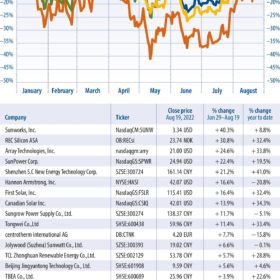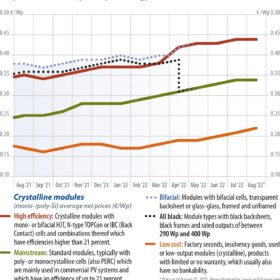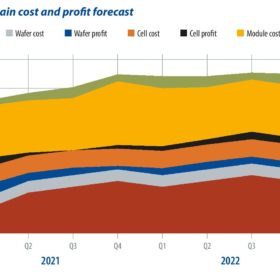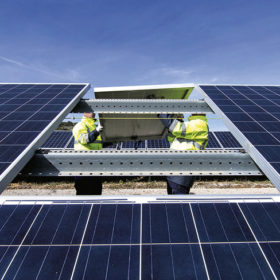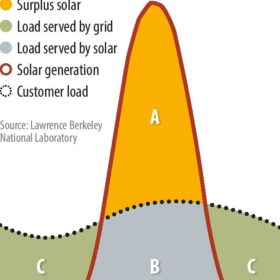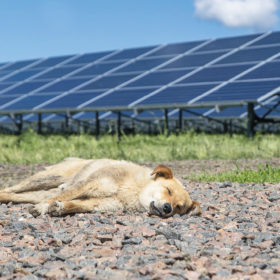Framed as savings
Sometimes it’s not what you say, but how you say it. The passing of the US Inflation Reduction Act represented a watershed moment for global climate policy, by virtue of its sheer size and the manner in which it addresses numerous segments of the energy economy. But it is also notable for the way in which the policy frames climate action as making good economic sense, for businesses and households alike.
Tracking the impacts
In the month of August, the Invesco Solar ETF underperformed relative to the S&P 500 and Dow Jones Industrial. Jesse Pichel of ROTH Capital Partners attributes this to uncertainty over the allocation of tariffs outlined in the US Inflation Reduction Act.
Test and measure
PV plants have to serve their purpose fault-free for a very long time, often under difficult conditions. Regular plant inspections are therefore a basic requirement for economical operation. Having dealt previously with visual inspection systems at the module level and their importance, Martin Schachinger of pvXchange and Falko Krause of GME Clean Power now shift their focus to more thorough, measurement-based inspections.
Local expansions counter tracker disruption
The solar tracker market experienced significant challenges during 2021, writes Jason Sheridan of IHS Markit, with major price increases and availability disruption across raw materials and delays to global freight operations. Despite these challenges, global solar tracker shipments grew to over 50 GW in 2021, representing 15% year-on-year growth. This was driven by strong demand in key markets such as the United States, Spain, mainland China, Brazil, and Chile. Solar tracker installations are expected to reach over 46 GW in 2022, an increase of 20% compared to 2021.
PV prices head for a Q3 peak
Global solar demand is projected to hit 240 GW to 270 GW this year, fueled by the accelerated global energy transition. Customs figures show that China exported nearly 89 GW of cells and modules to the world in the first half of 2022. Europe dominated this demand, importing 43 GW and accounting for nearly 50% of the total. InfoLink’s Amy Fang has also observed strong growth in China’s PV market, with distributed-generation projects contributing to 30.9 GW of new installations in the first half of 2022 – a 138% increase compared to the first half of 2021.
Mining for gold in legacy PPAs
As the pace of solar installations quickens, developers are racing to find the best remaining sites and optimize their position in interconnection queues. But what if the best investment opportunity is hidden in a site built a decade or more ago? Time gets the better of us all, and many early solar sites no longer perform as expected. Yet those sites generally sell power at prices today’s developers can only dream of. Chris Chappell and Stephen Shirey of Clean Energy Associates examine what can be done to unlock the value in these legacy sites.
A year of uncertainty
The supply of PV modules to the United States has been challenged by potential tariffs on goods shipped from four Southeast Asian nations that provide 80% of US solar panels. The disruption stems from an ongoing investigation into allegations of antidumping violations. US President Joe Biden has halted tariffs related for two years, but challenges still loom, reports pv magazine USA’s Ryan Kennedy.
Rallying for the ‘Solar+ Decade’
With energy challenges abounding, PV has emerged as a crucial part of the solution – building resiliency, creating jobs, and cutting emissions. In pursuit of energy markets and a system that embraces these features, Solar Energy Industries Association CEO Abigail Ross Hopper is advocating for more stable trade and policy settings, in order to facilitate the expansion of PV, in line with its “Solar+ Decade” goals.
Netting true value from batteries
Net metering reforms in the US are a missed opportunity to harness residential battery storage, argue researchers from the Lawrence Berkeley National Laboratory. Compensation rules for residential rooftop solar are evolving toward a model that encourages customers to use battery storage to maximize solar self-consumption. However, is this a good thing? Galen Barbose, Sydney P. Forrester, and Chandler Miller investigate.
Darkest hour before Ukraine’s solar dawn
Ukraine is still facing dire circumstances, with war continuing to claim lives and Russian invaders occupying large parts of the country. Solar plant owners also face serious challenges, including collateral damage, looting, destruction of communication infrastructure, and payment shortfalls. However, a bold vision for recovery has been set out with a key role for solar, as Ian Skarytovsky reports.

